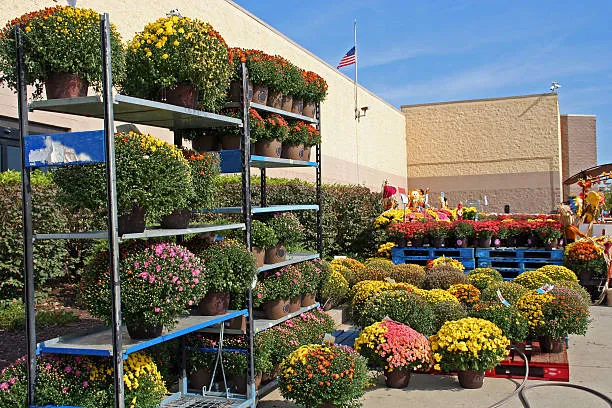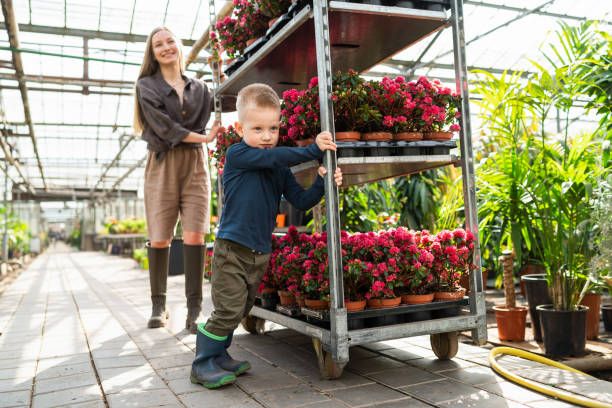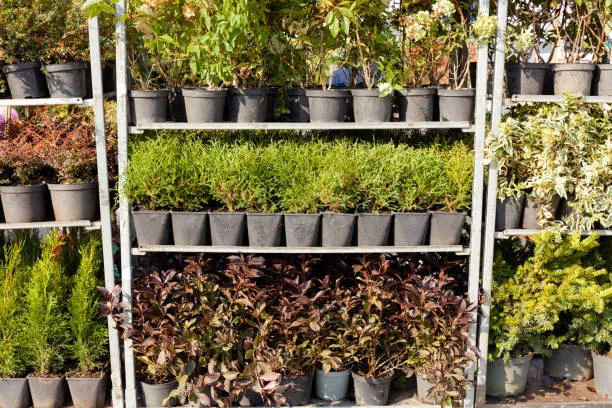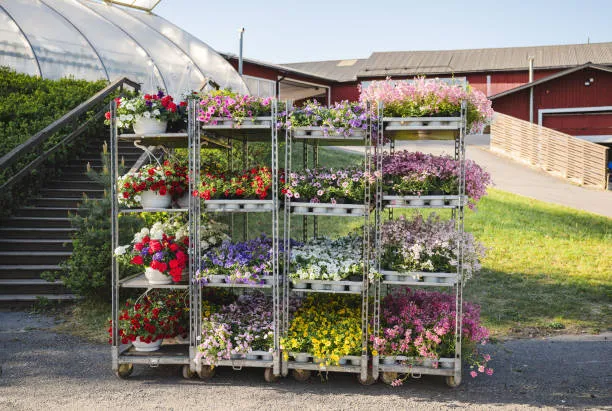Avoid your inquiry is delay response, please enter your WhatsApp/Skype along with the message, so we can contact you at the very first time.
We will reply you within 24 hours. If for urgent case, please add WhatsApp/WeChat: +8613791936882 ,. Or call +86-18678911083 directly.
I felt anxious watching petals wilt during bumpy rides. I wanted an easy fix that saved time and prevented damage. Then I found a straightforward transport method.
The easiest way to transport flowers is to use a sturdy flower trolley with secure shelves. This setup prevents tipping and reduces handling. It also speeds up loading and unloading tasks.

flower trolley
Let me share my findings on simple, reliable methods for moving flowers. I will also talk about how a dependable transport system can help keep blooms fresh and appealing.
I once struggled with bouquets turning limp during deliveries. I needed a stable solution that kept them upright while traveling. Then I discovered a method that protected every stem.
You can transfer fresh flowers by placing them upright in a secure stand or trolley, keeping them away from direct sunlight and extreme temperatures. Proper support preserves their shape.

secure floral transport
I learned that flowers demand constant care, even while in transit. I realized that minor mistakes—like leaving them in a hot vehicle or letting them slide around—led to drooping stems and bruised petals. My goal became ensuring that my flower deliveries looked as vibrant as when they left the greenhouse or shop.
I discovered that a solid trolley or rack is crucial. When I tried using simple cardboard boxes, the stems got tangled and fell over at tight corners. A flower trolley with adjustable shelves stabilizes delicate arrangements. These trolleys also allow for plenty of air circulation. Proper airflow helps flowers remain lively. I worked with Fangsheng – China’s leading manufacturer and supplier of Danish trolleys and flower trolleys. Their designs include rails or raised edges that keep pots from tipping over. This prevented me from continuously readjusting flowers during transit.
I once delivered flowers in sealed plastic sleeves without water. They looked fine at first, but they drooped by the time I reached my destination. Since then, I use small water picks or keep stems in shallow water trays. This method gives them enough moisture to remain fresh. I also avoid soaking the entire flower box because excess moisture can invite mold.
Direct sunlight or cold drafts can damage petals. When I place flowers in a vehicle, I pick a spot away from direct sun. If the weather is hot, I use reflective covers or place a light cloth over the bouquets to deflect heat. If it is cold, I try to maintain a moderate temperature in the transport area.
Gentle bracing around delicate arrangements helps them stay upright. I have used foam or bubble wrap for extra support. The key is ensuring they do not bounce around while moving the trolley or van. These small steps keep stems intact and guard blossoms against friction.
| Tip | Benefit |
|---|---|
| Use sturdy trolleys | Reduces shifting and breakage |
| Add water picks or shallow trays | Prevents dehydration during transport |
| Control temperature | Preserves color and petals |
| Support bouquets with padding | Minimizes bending or bruising |
Transferring flowers is simpler when you use the right equipment and techniques. A reliable trolley gives you the stability you need, so you do not need to worry about your blooms losing their luster. I have found that thorough preparation and small adjustments—like checking temperature and adding water sources—go a long way in preserving quality.
I remember feeling frustrated when a batch of potted plants toppled in the back of my truck. Soil spilled everywhere, and leaves broke off. I wanted a better solution to protect both the plants and my vehicle.
The best way to transport plants is to place them on a stable trolley or cart, allowing each pot enough space to prevent tipping or crushing. Proper spacing helps them stay healthy.

secure plant transport
Plants are living organisms, so they can be sensitive to sudden changes. I have learned methods to minimize stress on leaves, stems, and roots. Each approach matters when you aim to deliver plants that look fresh in retail or greenhouse environments.
When I tried loading plants in random plastic crates, pots kept banging against each other. A specialized plant trolley1 with sturdy shelves offers me a neat layout. Fangsheng’s flower trolleys accommodate various pot sizes, which proved useful for me. The adjustable shelf height allows different plant heights to fit without bending the stems. I also use rails to keep pots from sliding off.
I found that loose soil can spill if pots tip over. To prevent that, I slightly water the soil in advance to keep it packed. Not too much water, because I do not want muddy runoff. Another trick is to wrap the pot’s base with a biodegradable paper or small plastic cover to hold the soil in place. This ensures the trunk or stem remains stable during the ride.
Some plants have broad leaves or fragile branches. I once snapped leaves off a delicate plant because I loaded them too tightly. Now I place a soft divider between pots if they are close. I also angle tall plants so their foliage does not press against anything. For smaller or more delicate greenery, I might attach flexible ties gently to keep branches from rubbing against each other.
Plants can be more forgiving than fresh-cut flowers, but they still need moderate conditions. I try not to expose them to harsh sunlight through vehicle windows. If I plan a long trip, I make sure to provide ventilation so they do not overheat. When moving them in cold weather, I place them away from direct drafts or wind. A cloth cover sometimes helps insulate them.
| Method | Reason |
|---|---|
| Use a specialized trolley | Keeps pots stable and separated |
| Slightly water soil | Prevents excessive spillage |
| Cushion leaves and branches | Avoids breakage during movement |
| Maintain moderate temperature | Reduces plant stress and damage |
I have noticed that well-organized plant transport leads to happier customers. No one wants to buy a wilted or damaged plant. Using a good trolley system and a few protective measures solves many issues. Over time, I saw fewer breakages and less soil mess, which helped me streamline my workflow.
I once wondered if a trolley could hold an entire load of heavy potted arrangements. I felt nervous about exceeding capacity. The last thing I wanted was a collapsed shelf and damaged inventory.
A flower trolley can typically handle up to several hundred pounds, depending on its design and materials. High-quality trolleys from Fangsheng often carry heavier loads with plenty of stability.

flower trolley capacity
Not all trolleys are created equal. I learned this after using an older cart that had wobbly wheels and thin shelves. It buckled when I overloaded it with large pots. Then I discovered heavy-duty flower trolleys2 that use strong steel frames, thicker shelves, and robust casters. Understanding capacity is vital for planning daily tasks, preventing accidents, and avoiding product damage.
• Frame Material: Steel frames provide great strength. Aluminum is lightweight but might handle less weight unless it is reinforced.
• Shelf Design: Some trolleys have mesh shelves. Others feature solid wooden or metal shelves. The shelf thickness affects load-bearing capacity.
• Caster Quality: I made the mistake of buying cheap wheels once. They broke under stress. High-grade casters allow smooth rolling and support heavier loads.
I consulted Fangsheng’s specifications. Many of their trolleys handle loads from 100 kg (220 lbs) to over 500 kg (1100 lbs). This wide range helps me choose the right one for my business needs.
Even if a trolley has a high maximum capacity, improper weight distribution can cause leaning or tipping. I learned to place heavier pots near the center. Lighter items can go on top shelves. I also ensure that shelves are locked in place if they have adjustable heights. If I place too much weight on one side, wheels might wear out faster. So, I make sure the load is even.
Regular maintenance helps a trolley deliver consistent performance. I check wheels for debris. I confirm bolts and joints stay tight. If I see any sign of warping or bending, I fix it before it escalates. A well-kept trolley can handle its maximum capacity for a long time.
When I introduced new trolleys to my workflow, I did a test load. I placed heavier pots systematically, then rolled the trolley around carefully. I paid attention to how the frame responded. I tried turning so I could see if the trolley stayed stable. That test reassured me. If you run a bigger operation, load testing3 is a quick way to confirm that your chosen trolley matches your day-to-day demands.
Here is an example table showing load capacity ranges:
| Trolley Type | Approx Capacity | Frame Material | Shelf Type |
|---|---|---|---|
| Basic Stack Trolley | Up to 150 kg | Thin Steel | Mesh or Wire |
| Standard Flower Cart | 200–300 kg | Reinforced Steel | Wooden or Metal |
| Heavy-Duty Trolley | 500+ kg | Thick Steel | Solid Metal Sheets |
I found that bigger does not always mean better. Sometimes, I only need a smaller trolley if I move lighter items or fewer pots at once. This prevents me from carrying unnecessary bulk. Yet, if I manage large orders or handle heavier planters, a heavy-duty option is worth the investment.
Flower trolleys that support bigger loads often have adjustable shelves. This feature lets me store tall plants without fuss. I can also remove shelves to make space for large pots or oversize containers. That flexibility keeps the workflow smooth.
In my experience, a sturdy, well-constructed trolley from Fangsheng resists everyday wear and tear, handles large loads, and moves easily across greenhouse floors or warehouse aisles. This makes it an essential tool for growers, florists, or retailers who frequently transport bulk plants. I greatly value that reliability because it allows me to present fresh, well-kept flowers or plants to customers.
Transporting flowers and plants is easier with the right trolley. I place them in stable carts, ensure good support, control temperature, and manage loads wisely. This keeps them fresh and damage-free.